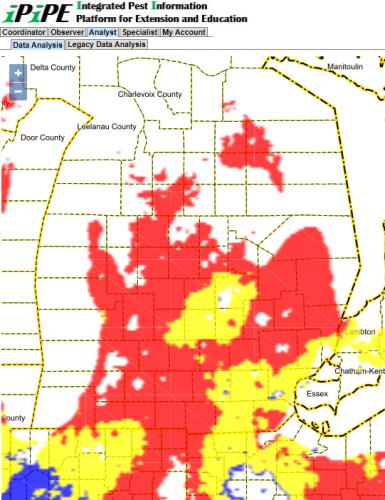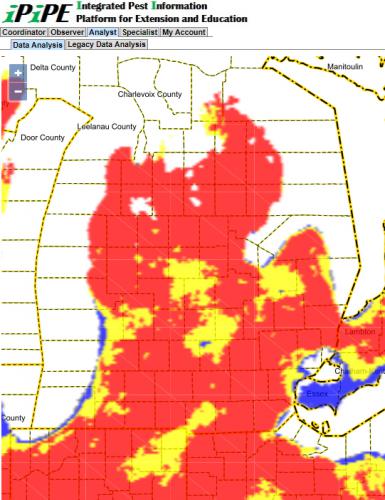Sclero-cast: A white mold apothecia risk indicator
Sclero-cast is a new tool to aid growers and consultants in identifying high risk conditions for white mold development in soybeans.
Sclero-cast was developed at the University of Wisconsin-Madison in collaboration with Michigan State University and Iowa State University. The model predicts the development of the white mold apothecia. Apothecia (mushrooms) produced by the white mold fungus release spores that infect flowers and initiate plant infection. To aid with in season management decisions, Sclero-cast must be used in conjunction with other risk factors, such as history of white mold and presence of sclerotia, flowering, row spacing and irrigation.
Sclero-cast model updates will be posted at the MSU Field Crop Pathology website.
**This tool is for guidance only and should be used with other sources of information and professional advice when determining risk of white mold development. MSU Extension encourages reading the Sclero-cast how-to guide.**
A quick guide:
- Select the model appropriate for your growing conditions (i.e., row spacing and irrigated versus non-irrigated).
- The model predicts the probability of the development of white mold apothecia (mushrooms) from sclerotia present in the field. Gray indicates a less than 5 percent chance of apothecia, blue indicates a 5-15 chance percent, yellow indicates a 15-30 percent chance and red indicates a greater than 30 percent chance. We recommend in-season fungicide application only if probabilities are greater than 30 percent (red).
- Are your soybeans flowering? Fungicide applications for optimal control should only be made between R1 (beginning flower) and R3 (beginning pod). If you are not flowering, you are at low risk.
- How open are your rows? For 15-inch row spacing less than 12 inches between row canopies elevates the risk, for 30-inch row spacing less than 24 inches between the row canopies elevates the risk. If the rows are open you are at lower risk.
If sclerotia are present in a field, row closure thresholds are met, soybeans are flowering and the map shows a greater than 30 percent (red) chance of apothecia development in a field, then soybeans are at high risk for developing white mold later in the season.

Non-irrigated 15- and 30-inch rows, July 18, 2017.

Irrigated 15-inch rows, July 18, 2017.

Irrigated 30-inch rows, July 18, 2017.
These models were developed to identify at-risk regions that have been experiencing weather favorable for the development of white mold fungus apothecia. Weather information and maps are provided by the Soybean Integrated Pest Information Platform for Extension and Education (iPIPE), which is managed by ZedX, Inc. This model predicts when apothecia will be present in the field using combinations of 30-day averages of maximum temperature, relative humidity and maximum wind speed.
Using virtually available weather data, predictions can be made in most soybean growing regions. Based on these predictions, a map is generated under three scenarios (non-irrigated soybeans, soybeans planted on 15-inch row spacing and irrigated, or soybeans planted on 30-inch row spacing and irrigated).
The maps are colored to show the likelihood of apothecial presence within a region. White areas indicate the model is inactive and risk of apothecia in the field is likely low. Gray areas indicate apothecia might be present, but likelihood of apothecial presence is less than 5 percent. Blue indicates a low risk (5 to 15 percent chance), yellow a moderate risk (15 to less than 30 percent chance) and red areas indicate a high risk (30 percent or higher chance).
Model predictions must be combined with soybean growth stage and canopy characteristics to aid in timing of fungicide sprays. If the model is predicting high risk (red) in your area for your planting scenario, the soybeans are flowering, and the canopy is somewhat closed, then the white mold risk is elevated.
If your fields are at risk, we recommend consulting your local MSU Extension educator or resources for the best in-season management options for your area.
For further information on how to use and interpret these risk maps, read the Sclero-cast how-to guide.
Dr. Chilver’s work is funded in part by MSU’s AgBioResearch.



 Print
Print Email
Email




